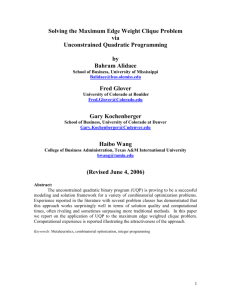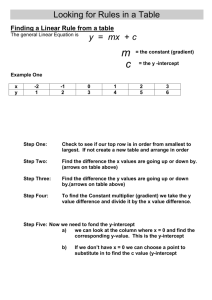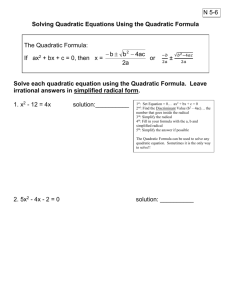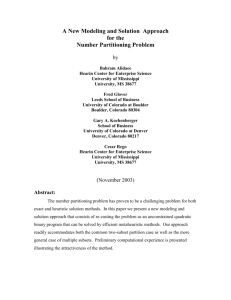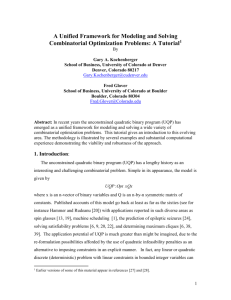A Unified Modeling and Solution Framework for Combinatorial
advertisement
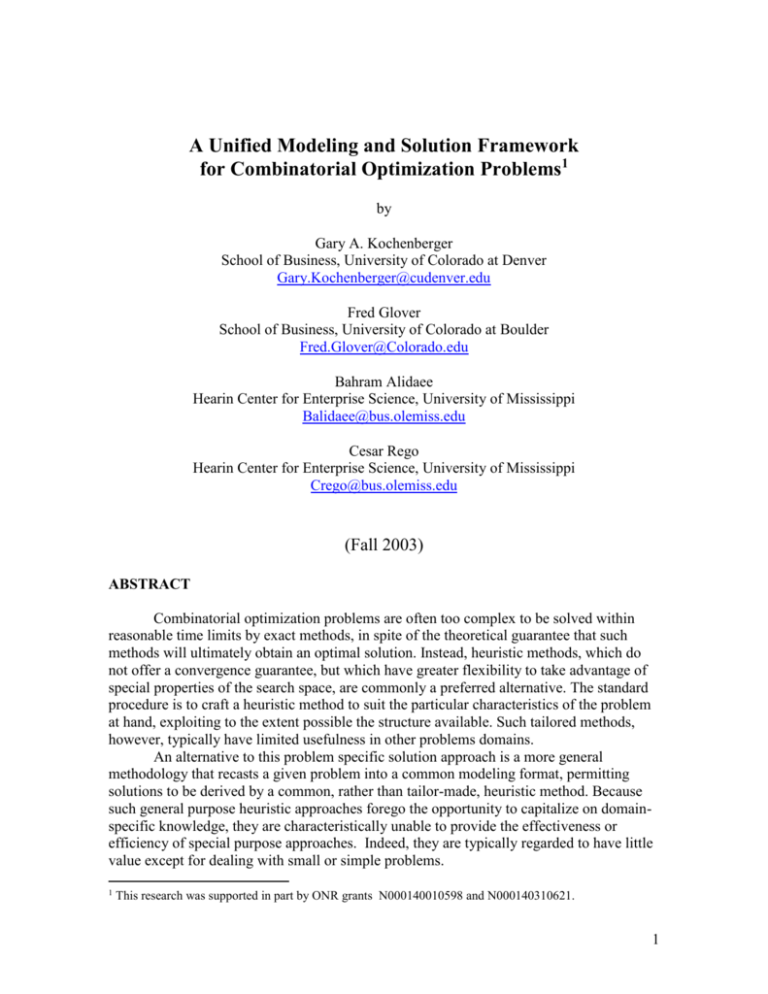
A Unified Modeling and Solution Framework for Combinatorial Optimization Problems1 by Gary A. Kochenberger School of Business, University of Colorado at Denver Gary.Kochenberger@cudenver.edu Fred Glover School of Business, University of Colorado at Boulder Fred.Glover@Colorado.edu Bahram Alidaee Hearin Center for Enterprise Science, University of Mississippi Balidaee@bus.olemiss.edu Cesar Rego Hearin Center for Enterprise Science, University of Mississippi Crego@bus.olemiss.edu (Fall 2003) ABSTRACT Combinatorial optimization problems are often too complex to be solved within reasonable time limits by exact methods, in spite of the theoretical guarantee that such methods will ultimately obtain an optimal solution. Instead, heuristic methods, which do not offer a convergence guarantee, but which have greater flexibility to take advantage of special properties of the search space, are commonly a preferred alternative. The standard procedure is to craft a heuristic method to suit the particular characteristics of the problem at hand, exploiting to the extent possible the structure available. Such tailored methods, however, typically have limited usefulness in other problems domains. An alternative to this problem specific solution approach is a more general methodology that recasts a given problem into a common modeling format, permitting solutions to be derived by a common, rather than tailor-made, heuristic method. Because such general purpose heuristic approaches forego the opportunity to capitalize on domainspecific knowledge, they are characteristically unable to provide the effectiveness or efficiency of special purpose approaches. Indeed, they are typically regarded to have little value except for dealing with small or simple problems. 1 This research was supported in part by ONR grants N000140010598 and N000140310621. 1 This paper reports on recent work that calls this commonly held view into question. We describe how a particular unified modeling framework, coupled with latest advances in heuristic search methods, makes it possible to solve problems from a wide range of important model classes. Introduction: The optimization folklore strongly emphasizes the unproductive consequences of converting problems from a specific class to a more general representation, since the “domain-specific structure” of the original setting then becomes invisible and can not be exploited by a method for the more general problem representation. Nevertheless, there is a strong motivation to attempt such a conversion in many applications to avoid the necessity to develop a new method for each new class. We demonstrate the existence of a general problem representation that frequently overcomes the limitation commonly ascribed to such models. Contrary to expectation, when a specially structured problem is translated into this general form, it often does not become much harder to solve, and sometimes becomes even easier to solve, provided the right type of solution approach is applied. Our research over the past few years has revealed that this unified approach is surprisingly successful for a wide range of important problems, often surpassing the performance of established special-purpose methods for particular problem classes. As such, this unified approach holds great promise as a practical method for solving a variety of important problems. The Unified Model: The model with this appealing property is the unconstrained quadratic binary programming problem, accompanied by the device of introducing quadratic infeasibility penalty functions to handle constraints. Not only is this model capable of representing many “special case” problem classes, but it can be advantageously exploited by adaptive memory (tabu search) metaheuristics and associated evolutionary (scatter search) methods. Computational outcomes disclose the effectiveness of this combined modeling and 2 solution approach for problems from a diverse collection of challenging settings. The unconstrained quadratic program can be written in the form: UQP: min f ( x) xQx where Q is an n by n matrix of constants and x is an n-vector of binary variables. UQP is notable for its ability to represent a significant variety of important problems. The applicability of this representation has been reported in diverse settings such as spin glasses and circuit board layout (De Simone, et. al. [11], Grotschel, et. al. [19] and Palubeckis [33]), financial analysis (Laughunn, [30], McBride and Yormak, [31]), computer aided design (Krarup and Pruzan [29]), traffic management (Gallo et al. [13, Witsgall, [40]), machine scheduling (Alidaee, Kochenberger, and Ahmadian, [1]), cellular radio channel allocation (Chardaire and Sutter [9]), molecular conformation (Phillips and Rosen [37]) and the prediction of epileptic seizures (Iasemidus, et. al. [25]. Moreover, many satisfiability problems (Hammer and Rudeanu [21], Boros and Hammer [5], Boros and Prekopa [7]) as well as combinatorial optimization problems pertaining to graphs such as determining maximum cliques, maximum cuts, maximum vertex packing, minimum coverings, maximum independent sets, and maximum independent weighted sets are known to be capable of being formulated by the UQP problem (see for instance Boros and Hammer [5 ], Bourjolly, et. al. [8], Hammer et. al. [20] as well as Du and Pardalos [12], Pardalos and Rodgers [34,35], and Pardalos and Xue [36]). The application potential of UQP is substantially greater than this, however, due to reformulation methods that enable certain constrained models to be re-cast in the form of UQP. Hammer and Rudeanu [21], Hansen [22], and Hansen et. al. [23] show that any quadratic (or linear) objective in bounded integer variables and constrained by linear equations can be reformulated as a UQP model. Nonetheless, few applications of this idea appear in the literature. Our purpose here, based on extensive experience with a wide variety of problems, is to establish that such reformulation into the UQP format is not merely a representational novelty, but a unified framework of practical consequences. 3 Transformation to xQx: Many practical combinatorial optimization problems can be modeled as constrained optimization problems of the form min x0 xQx subject to Ax b, x binary The foregoing model accommodates both quadratic and linear objective functions since the linear case results when Q is a diagonal matrix (observing that xj2 = xj when xj is a 0-1 variable). Problems with inequality constraints can also be put into this form by introducing so-called slack variables to convert the inequalities into equations, and representing these bounded slack variables by a binary expansion. These constrained quadratic optimization models are then converted into equivalent UQP models by adding a quadratic infeasibility penalty function to the objective function as an alternative to explicitly imposing the constraints Ax b . The general approach to such re-casting, which we call transformation # 1, is given below: Transformation 1. We choose a positive scalar P, to yield x0 xQx P Ax b Ax b t xQx xDx c xQˆ x c where the matrix D and the additive constant c result directly from the matrix multiplication indicated. We can drop the additive constant, whereupon the equivalent unconstrained version of our constrained problem becomes UQP( PEN ) : min xQˆ x, x binary From a theoretical standpoint, a suitable choice of the penalty scalar P can always be chosen so that the optimal solution to UQP(PEN) is the optimal solution to the original constrained problem (Hammer and Rudeanu [21). From a practical standpoint, however, 4 experience has shown that penalty-based conversions in other settings have uniformly proved to be highly unstable, engendering numerical difficulties and poor solution performance when the penalties are large, and producing invalid representations of the original problem when the penalties are smaller. Finding a proper trade-off between penalty size (and the design of a method to exploit the penalized representation) has turned out to be feasible only in the case of linear and convex programming domains, where penalty considerations are much simpler than in combinatorial optimization. By contrast, however, our experience with penalty-based representations of the UQP model for combinatorial optimization problems has shown them to be easy to work with and highly robust. As reported in [27], valid and computationally stable penalty values can be found without difficulty and a wide range of such values work well. In addition to the modeling possibilities introduced by Transformation 1, a very important special class of constraints that arise in many applications can be handled by an alternative approach, given below. Transformation 2. This approach is convenient for problems with considerations that isolate two specific alternatives and prohibit both from being chosen. That is, for a given pair of alternatives, one or the other but not both may be chosen. If xj and xk are binary variables denoting whether or not alternatives j and k are chosen, the standard constraint that allows one choice but precludes both is: x j xk 1 Then, for a positive scalar P, adding the penalty function Px j x k to the objective function is a simple alternative to imposing the constraint in a traditional manner. For problems with a linear objective function, the scalar P (with respect to transformation # 2) can be chosen as small as the largest objective function coefficient [ 5]. This penalty function has sometimes been used by to convert certain optimization problems on graphs into an equivalent UQP model as referenced in the previous section. Its potential application, however, goes far beyond these settings as demonstrated in this paper. Variable upper bound constraints of the form xij yi can be accommodated by Transformation 2 by first replacing each y i variable by 1 – y i ', where y i ' is the complementary variable that equals 1 when y i = 0 5 and equals 0 when y i = 1. The opportunity to employ this modeling device in the context of Transformation 2 makes it possible to conveniently model a variety of additional problem types. The constraint associated with Transformation # 2 appears in many important applications which leads us to single it our here as an important alternative to Transformation # 1. We note, however, that many other problem specific special cases exist that can be employed to quickly yield quadratic equivalent representations. We illustrate this later in the paper when we discuss results we have obtained for the max 2SAT problem. Examples: Before highlighting some of the problem classes to which we have successfully applied the foregoing transformation approaches, we give two small examples from classical NP-hard problem settings to provide concrete illustrations. Example 1: Set Partitioning. The classical set partitioning problem is found in applications that range from vehicle routing to crew scheduling [26], [32]. As an illustration, consider the following small example: min x0 3x1 2 x2 x3 x4 3x5 2 x6 subject to x1 x3 x6 1 x 2 x3 x5 x 6 1 x3 x 4 x5 1 x1 x 2 x 4 x6 1 and x binary. Applying Transformation 1 with P =10 gives the equivalent UQP model: UQP ( PEN ) : min xQˆ x, x binary where the additive constant, c, is 40 and 6 0 20 17 10 10 10 10 18 10 10 10 20 10 10 29 10 20 20 Q̂ 10 10 10 19 10 10 0 10 20 10 17 10 20 20 20 10 10 28 Solving UQP(PEN) by the Tabu Search method of Glover et al. [17, 18] we obtain an optimal solution x1 x5 1, (all other variables equal to 0) for which x0 6 . In the straightforward application of Transformation 1 to this example, it is to be noted that the replacement of the original problem formulation by the UQP(PEN) model did not involve the introduction of new variables. In many applications, Transformation 1 and Transformation 2 can be used in concert to produce an equivalent UQP model, as demonstrated next. Example 2: The K-Coloring Problem: Vertex coloring problems seek to assign colors to nodes of a graph such that adjacent nodes are assigned different colors. The K-coloring problem attempts to find such a coloring using exactly K colors. A wide range of applications, ranging from frequency assignment problems to printed circuit board design problems [10, [39], can be represented by the K-coloring model. Such problems can be modeled as satisfiability problems using the assignment variables as follows: Let xij to be 1 if node i is assigned color j, and to be 0 otherwise. Since each node must be colored, we have K xij 1 i 1,..., n (1) j 1 where n is the number of nodes in the graph. A feasible coloring requires that adjacent nodes are assigned different colors. This is accomplished by imposing the constraints xip x jp 1 p 1,..., K (2) 7 for all adjacent nodes (i,j) in the graph. This problem can be re-cast into the form of UQP by using Transformation 1 on the assignment constraints of (1) and Transformation 2 on the adjacency constraints of (2). No new variables are required. Since the model of (1) and (2) has no explicit objective function, any positive value for the penalty, P, will do. The following example gives a concrete illustration of the re-formulation process. Consider the following graph and assume we want find a feasible coloring of the nodes using 3 colors. 1 5 2 4 3 Our satisfiablity problem is that of finding a solution to: xi1 xi 2 xi 3 1 xip x jp p 1, 3 1 i 1, 5 (3) (4) (for all adjacent nodes i and j) In this traditional form, the model has 15 variables and 26 constraints. To recast this problem into the form of UQP, we use Transformation 1 on the equations of (3) and Transformation 2 on the inequalities of (4). Arbitrarily choosing the penalty P to be 4, we get the equivalent problem: UQP ( Pen) : min xQˆ x where the Q̂ matrix is: 8 4 4 0 0 0 0 0 0 0 0 4 0 0 4 4 4 4 4 0 4 0 0 0 0 0 0 0 0 4 0 4 4 0 0 4 0 0 0 0 0 0 0 0 4 4 0 4 4 4 4 0 0 4 0 0 4 0 0 4 0 0 4 0 4 4 4 0 4 0 0 4 0 0 4 0 0 4 4 4 4 0 0 4 0 0 4 0 0 4 0 0 0 4 0 0 4 4 4 4 0 0 0 0 0 0 Q̂ 0 0 0 0 4 0 4 4 4 0 4 0 0 0 0 0 0 0 0 4 4 4 4 0 0 4 0 0 0 0 0 0 4 0 0 4 0 0 4 4 4 4 0 0 0 0 0 0 0 4 0 0 4 0 4 4 4 0 4 0 0 0 0 0 4 0 0 4 4 4 4 0 0 4 0 0 4 0 0 0 0 0 4 0 0 4 4 4 4 0 0 4 0 0 4 0 0 0 0 0 4 0 4 4 4 0 4 0 0 4 0 0 0 0 0 4 4 4 4 0 Solving this unconstrained model, xQˆ x , yields the feasible coloring: x11, x22, x33, x41, x53, 1 all other xij 0 This approach to coloring problems has proven to be very effective for a wide variety of coloring instances from the literature. Later in this paper we present some computational results for several standard k-coloring problems. An extensive presentation of the xQx approach to a variety of coloring problems, including a generalization of the K-coloring problem considered here, is given in Kochenberger, Glover, Alidaee and Rego [28]. Solution Approaches to UQP: Due to its computational challenge and application potential, UQP has been the focus of a considerable number of research studies in recent years, including both exact and heuristic solution approaches. Recent papers report on the branch and bound (exact) approaches as well as a variety of modern heuristic methods including simulated annealing, genetic algorithms, tabu search, and scatter search. (See [27] for references to these and other works.) Each of these approaches exhibits some degree of success. 9 However, the exact methods degrade rapidly with problem size, and have meaningful application to general UQP problems with no more than 100 variables. (A notable exception to this for the Ising spin glass problem is discussed in [11].) For larger problems, heuristic methods are usually required. Several proposed heuristics, including the DDT method of Boros, Hammer and Sun [6] and the “one-pass” procedures of Glover, Alidaee, Rego and Kochenberger [16] have proven to be effective in certain instances. Two methods we have found to be particularly successful for a wide variety of problems are based on tabu search [14, 17, 18] and on the related evolutionary strategy scatter search [15]. In the following section we highlight our tabu search approach which was used to produce the computational results referenced later in this paper. Although not pursued by us here, we note that an alternative approach is to solve UQP as a continuous non-linear optimization problem within the unit cube. This allows other heuristic/approximation methods based on continuous optimization methodologies to be applied (see [4], [7], [38]). Tabu Search Overview: Our TS method for UQP is centered around the use of strategic oscillation, which constitutes one of the primary strategies of tabu search. The variant of strategic oscillation we employ may be sketched in overview as follows. The method alternates between constructive phases that progressively set variables to 1 (whose steps we call “add moves”) and destructive phases that progressively set variables to 0 (whose steps we call “drops moves”). To control the underlying search process, we use a memory structure that is updated at critical events, identified by conditions that generate a subclass of locally optimal solutions. Solutions corresponding to critical events are called critical solutions. A parameter span is used to indicate the amplitude of oscillation about a critical event. We begin with span equal to 1 and gradually increase it to some limiting value. For each value of span, a series of alternating constructive and destructive phases is executed before progressing to the next value. At the limiting point, span is gradually decreased, allowing again for a series of alternating constructive and destructive phases. When span reaches a value of 1, a complete span cycle has been completed and the next cycle is 10 launched. Information stored at critical events is used to influence the search process by penalizing potentially attractive add moves (during a constructive phase) and inducing drop moves (during a destructive phase) associated with assignments of values to variables in recent critical solutions. Cumulative critical event information is used to introduce a subtle long term bias into the search process by means of additional penalties and inducements similar to those discussed above. A complete description of the framework for the method is given in Glover, Kochenberger, Alidaee and Amini [17]. Computational Experience: Our results of applying the tabu search and associated scatter search metaheuristics to combinatorial problems recast in UQP form have been uniformly attractive in terms of both solution quality and computation times. Although our methods are designed for the completely general form of UQP, without any specialization to take advantage of particular types of problems reformulated in this general representation, our outcomes have typically proved competitive with or even superior to those of specialized methods designed for the specific problem structure at hand. Our broad base of experience with UQP as a modeling and solution framework includes a substantial range of problem classes including: Quadratic Assignment Problems Capital Budgeting Problems Multiple Knapsack Problems Task Allocation Problems (distributed computer systems) Maximum Diversity Problems P-Median Problems Asymmetric Assignment Problems Symmetric Assignment Problems Side Constrained Assignment Problems Quadratic Knapsack Problems Constraint Satisfaction Problems (CSPs) Discrete Tomography Problems Set Partitioning Problems 11 Set Packing Problems Warehouse Location Problems Maximum Clique Problems Maximum Independent Set Problems Maximum Cut Problems Graph Coloring Problems Number Partitioning Problems Linear Ordering Problems Clique Partitioning Problems SAT problems We are currently solving problems via UQP with more than 13,000 variables in the quadratic representation and are working on enhancements that will permit larger instances to be solved. For each of the problem classes listed above we have considerable computational experience showing that this approach consistently produces high quality solutions within very modest computational time. Below we present some representative results for two of the problem classes. Details of our experience with other problems will be presented in future papers. K-Coloring Results Earlier in the paper we presented a small example of the 3-coloring problem. To test the potential attractiveness of the UQP modeling and solution approach to K-coloring problems, 15 standard test problems from the literature were recast into the form of UQP and solved by our tabu search method. Table 1 gives a description of the problems and presents the results. All computations were carried out on a 1.7 gigahertz PC. ID Myciel3 # Vertices 11 # Edges 20 4 # xQx xQx xQx Variables feasible Time 44 Yes < 1 sec K Myciel4 23 71 5 115 Yes < 1 sec Myciel5 47 236 6 282 Yes < 1 sec Myciel6 95 755 7 665 Yes < 1 sec Myciel7 191 2360 8 1528 Yes < 1 sec 12 Anna 138 493 11 1518 Yes 47 sec David 87 406 11 957 Yes 1 min, 13sec Huck 74 301 11 814 Yes 2 sec Jean 80 254 10 800 Yes < 1 sec Games120 120 638 9 1080 Yes < 1 sec Queen5_5 25 160 5 125 Yes < 1 sec Queen6_6 36 290 7 252 Yes < 1 sec Queen7_7 49 476 7 343 Yes < 1 sec Queen8_12 96 1368 12 1162 Yes < 1 sec Queen8_8 64 728 9 576 Yes < 1 sec Table 1: K-coloring test problems from http://mat.gsia.cmu.edu/COLOR/instances.html. The first four columns of Table 1 indicate the problem identifier along with the size of the graphs and the number of colors (K) to be used. The last three columns give the number of variables involved, whether or not a feasible coloring was found utilizing K colors, and the time our tabu search method took to find a solution. Note that feasible colorings (solutions) were quickly found in all 15 cases. In fact, the solutions shown in Table 1 are known to be optimal. Max 2-SAT Results: Several authors (Hammer and Rudeanu [21], Hansen and Jaumard [24], Boros and Hammer [5]) have established the connection between SAT problems and nonlinear penalty functions. The special case of Max 2-SAT is particularly well suited for this approach as it leads naturally to an xQx representation. Our experience, as shown below, indicates that this is a very attractive way to approach this class of problems. For a 2-SAT problem, a given clause could have zero, one, or two negations, each with a corresponding (classical) linear constraint. Each linear constraint, in turn, has an exact quadratic penalty that serves as an alternative to the linear constraint. The three possibilities and their constraint/penalty pairs are: 13 (a) No negations: Classical constraint: Exact Penalty: xi x j 1 (1 xi x j xi x j ) (b) One negation: Classical constraint: xi Exact Penalty: xj 1 ( x j xi x j ) (c) Two negations: Classical constraint: xi Exact Penalty: xj 1 ( xi x j ) It is easy to see that the quadratic penalties shown are zero for feasible solutions and positive for infeasible solutions. Thus, these special penalties can be used to readily construct a penalty function of the form of xQx (simply by adding the penalties together) which we seek to minimize. We have found this approach to be very effective on a variety of test problems. Table 2 shows the results we obtained via this approach on a set of test problems from the literature. n m 50 50 50 50 50 50 50 50 50 100 100 100 100 100 150 150 100 150 200 250 300 350 400 450 500 200 300 400 500 600 300 450 best known xQx xQx Maxsat3 Maxsat solution solution time solution time 4 8 16 22 32 41 45 63 66 5 15 29 44 65 4 22 <1 <1 <1 <1 <1 <1 <1 <1 <1 <2 <2 <2 <2 <2 <3 <3 4 8 16 22 32 41 45 63 66 5 15 29 44 ? 4 22 4 8 16 22 32 NA NA NA NA 5 15 NA NA NA 4 NA .4 1.5 116.2 652.4 8,763 > 12 hr > 12 hr > 12 hr > 12 hr 3.2 13,770 > 12 hr > 12 hr > 12 hr 4.1 > 12 hr 14 150 600 38 38 Table 2. Problems from Borchers & Furman [3] <3 NA > 12 hr Remarks: 1. All times in seconds unless noted otherwise. 2. Maxsat is an exact method developed by Borchers & Furman 3. Maxsat results obtained on IBM RS/6000-590 4. xQx results obtained on a 1.6 MHZ PC. 5. Each xQx run was for 50 SPAN cycles 6. Problem 100_600 was previously unsolved. As shown in the table, by re-casting each Max 2-SAT instance into the form of xQx and solving the resulting unconstrained quadratic binary program with our Tabu Search heuristic, we were able to find best known solutions very quickly to all test problems considered. By way of contrast, the method of Borchers and Furman took a very long time on several problems and was unable to find best known results for several instances in the allotted 12 hour time limit. In addition to the problems of table 2 above, we have successfully applied this approach to randomly generated problems with as many as 1000 variables and more than 10,000 clauses where best known results are found in roughly one minute of computation time. The results shown in tables I and II above serve as strong evidence of the attractiveness of the xQx approach for the problems considered. Considering both solution quality and the time taken to produce these solutions, this approach is very competitive with special purpose methods constructed specifically for vertex coloring and max 2-Sat problems. We note in passing that similar performance relative to special purpose methods has been obtained for the other problem classes singled out earlier in the paper as well. Summary: We have demonstrated how a variety of disparate combinatorial problems can be solved by first re-casting them into the common modeling framework of the unconstrained quadratic binary program. Once in this unified form, the problems can be solved effectively by adaptive memory tabu search metaheuristics and associated evolutionary (scatter search) procedures. 15 Our findings challenge the conventional wisdom that places high priority on preserving linearity and exploiting specific structure. Although the merits of such a priority are well-founded in many cases, the UQP domain appears to offer a partial exception. In forming UQP(PEN), we destroy any linearity that the original problem may have exhibited. Moreover, any exploitable structure that may have existed originally is “folded” into the Q̂ matrix, and the general solution procedure we apply takes no advantage of it. Nonetheless, our solution outcomes have been remarkably successful, yielding results that rival the effectiveness of the best specialized methods. This combined modeling/solution approach provides a unifying theme that can be applied in principle to all linearly constrained quadratic and linear programs in bounded integer variables, and the computational findings for a broad spectrum of problem classes raises the possibility that similarly successful results may be obtained for even wider ranges of problems. As our methods for UQP continue to improve with ongoing research, the UQP model offers a representational tool of particular promise. 16 References 1. . Alidaee, B, G. Kochenberger, and A. Ahmadian, “0-1 Quadratic Programming Approach for the Optimal Solution of Two Scheduling Problems,” International Journal of Systems Science, 25, 401-408, 1994. 2. Amini, M., B. Alidaee, G. Kochenberger, “A Scatter Search Approach to Unconstrained Quadratic Binary Programs,” New Methods in Optimization, Cone, Dorigo, and Glover, eds., McGraw-Hill, 317-330, 1999. 3. Borchers, B. and J. Furman, “A Two-Phase Exact Algorithm for Max-SAT and Weighted Max SAT,” J. of Combinatorial Optimization, 2,299-306 (1999). 4. Boros, E., and P. Hammer, “The Max-Cut Problem and Quadratic 0-1 Optimization, Polyhedral Aspects, Relaxations and Bounds,” Annals of OR, 33,151-225 (1991) 5. Boros, E. and P. Hammer, “ Pseudo-Boolean Optimization,” Discrete Applied Mathematics, 123(1-3), 155-225 (2002) 6. Boros, E, P. Hammer, and X, Sun, “The DDT Method for Quadratic 0-1 Minimization,” RUTCOR Research Center, RRR 39-89, 1989. 7. Boros, E. and A. Prekopa, “Probabilistic Bounds and Algorithms for the Maximum Satisfiability Problem,” Annals of OR, 21 (1989), pp. 109-126. 8. Bourjolly, J.M., P. Gill, G. Laporte, and H. Mercure, “A Quadratic 0/1 Optimization Algorithm for the Maximum Clique and Stable Set Problems,” Working paper, University of Montreal, (1994). 9. Chardaire, P, and A. Sutter, “A Decomposition Method for Quadratic Zero-One Programming,” Management Science, 41:4, 704-712, 1994. 17 10. Cho, J-D, S. Raje, and M. Sarrafzadeh, “Fast Approximation Algorithms on Maxcut, K-Coloring, and K-Color Ordering for VLSI Applications,” IEE Transactions on Computers, 47, 1253-1266, 1998 11. De Simone, C. M. Diehl, M. Junger, P. Mutzel, G. Reinelt, and G. Rinaldi, ‘Exact Ground State4s of Ising Spin Glasses: New Experimental Results with a Branch and Cut Algorithm,” Journal of Statistical Physics, 80, 487-496 (1995) 12. Du, D. and P. Pardalos, (ed), Handbook of Combinatorial Optimization, (4 volumes), Kluwer Academic Publishers, 1998-99. 13. Gallo, G, P. Hammer, and B. Simeone, “Quadratic Knapsack Problems,” Mathematical Programming, 12, 132-149, 1980. 14. Glover, F, and M. Laguna, “Tabu Search,” Kluwer Academic Publishers, 1997. 15. Glover, F., “A Template for Scatter Search and Path Relinking,” School of Business, University of Colorado, Technical Report, February 1998. 16. Glover, F., B. Alidaee, C. Rego, and G. Kochenberger, “One-Pass Heuristics for LargeScale Unconstrained Binary Quadratic Programs,” EJOR 137, pp. 272-287, 2002. 17. Glover, F., G. Kochenberger, B. Alidaee, and M.M. Amini, “Tabu with Search Critical Event Memory: An Enhanced Application for Binary Quadratic Programs,” In: MetaHeuristics: Advances and Trends in Local Search Paradigms for Optimization, (Eds.) S. Voss, S. Martello, I. Osman, and C. Roucairol. Kluwer Academic Publisher, Boston, 1999. 18. Glover, F., G. Kochenberger., and B. Alidaee, “Adaptive Memory Tabu Search for Binary Quadratic Programs,” Management Science, 44:3, 336-345, 1998. 18 19. Grotschel, M., M. Junger, and G. Reinelt, “An Application of Combinatorial Optimization to Statistical Physics and Circuit Layout Design,” Operations Research, Vol.36, #3, May-June, (1988), pp. 493-513. 20. Hammer, P., P. Hansen, and B. Simone, “Upper Planes of Quadratic 0/1 Functions and Stability in Graphs,” Nonlinear Programming 4, O. Mangasarian, R. Meyer, and S. Robinson (eds), Academic Press, New York, (1981), pp. 395-414. 21. Hammer, P., and S. Rudeanu, Boolean Methods in Operations Research, SpringerVerlag, New York, 1968. 22. Hansen, P.B., “Methods of Nonlinear 0-1 Programming,” Annals Discrete Math, vol. 5, pp.53-70, 1979. 23. Hansen, P, B. Jaumard., and V. Mathon, “Constrained Nonlinear 0-1 Programming,” INFORMS Journal on Computing, 5:2, 97-119, 1993. 24. Hansen, P. and B. Jaumard, “Algorithms for the Maximum Satisfiability Problem,” Computing, 44, 279-303 (1990). 25. Iasemidis, L. D., D. S. Shiau, J.C. Sackellares, and P. Pardalos, “Transition to Epileptic Seizures: Optimization,” DIMACS Series in Discrete Math and Theoretical Computer Science, Vol. 55, (2000), pp. 55-73. 26. Joseph, A. “A Concurrent Processing Framework for the Set Partitioning Problem,” Computers & Operations Research, 29, 1375-1391, 2002. 27. Kochenberger, G., F. Glover, B. Alidaee, and C. Rego, “Solving Combinatorial Optimization Problems via Reformulation and Adaptive Memory Metaheuristics,”Working Paper, University of Colorado at Denver, 2002. 19 28. Kochenberger, G., F. Glover, B. Alidaee, and C. Rego, “ An Unconstrained Quadratic Binary Programming Approach to the Vertex Coloring Problem,” Working Paper, University of Colorado at Denver, 2002. 29. Krarup, J, and A. Pruzan, “Computer Aided Layout Design,” Mathematical Programming Study, 9, 75-94, 1978. 30. Laughunn, D.J, “Quadratic Binary programming,” Operations Research, 14, 454-461, 1970. 31. McBride, R.D., and J.S. Yormack, “An Implicit Enumeration Algorithm for Quadratic Integer Programming,” Management Science, 26, 282-296, 1980. 32. Mingozzi, A., M. Boschetti, S. Ricciardelli and L. Blanco, “A Set Partitioning Approach to the Crew Scheduling Problem,” Operations Research, 47 (6) 873888, 1999. 33. Palubeckis, G. “A Heuristic-Branch and Bound Algorithm for the Unconstrained Quadratic Zero-One Programming Problem,” Computing, pp. 284-301, (1995). 34. Pardalos, P, and G.P. Rodgers, “Computational Aspects of a Branch and Bound Algorithm for Quadratic Zero-one Programming,” Computing, 45, 131-144, 1990. 35. Pardalos, P, and G.P. Rodgers, “A Branch and Bound Algorithm for Maximum Clique problem,” Computers & OR, 19, 363-375, 1992. 36. Pardalos, P, and J. Xue, “The Maximum Clique Problem,” The Journal of Global Optimization, 4, 301-328, 1994. 37. Phillips, A.T., and J.B. Rosen, “A Quadratic Assignment Formulation of the Molecular Conformation Problem,” The Journal of Global Optimization, 4, 229-241, 1994. 38. Rosenberg, I.G., “0-1 Optimization and Non-linear Programming.” Revue Francaise 20 d’Automatique, d’Informatique et de Rescherche Operationnelle, (S\’erie Blueu) 2, 9597, (1972). 39. Tsuda, N., “Fault-Tolerant Processor Arrays Using Additional Bypass Linking Allocated by Graph-Node Coloring,” IEEE Transactions on Computers, 49, 431-442, 2000. 40. Witsgall, C., “Mathematical Methods of site Selection for Electronic System (EMS),” NBS Internal Report, 1975. 21


